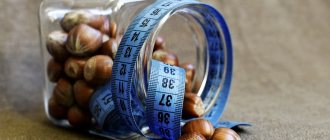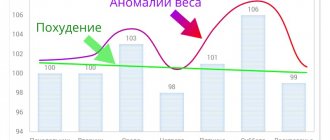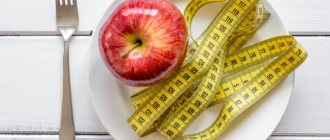People are motivated by results. When they see significant positive changes in their figure after training in the gym, dieting and giving up unhealthy foods, they continue to work even harder on themselves. Measuring your own body parameters also helps with this.
To have an idea of how effective a particular method of work is, it is not enough to weigh yourself on a scale. It is necessary to record the measurement results in a table and enter them in the appropriate fields in order to see progress. This will make it possible to adjust your diet and training program.
Why take measurements?
Many people consider diet a panacea for excess weight. In fact, the effect of cleansing the body occurs, excess water leaves the tissues. But at the same time, the volumes remain the same. And with strict diets, a completely opposite effect is possible due to the fact that the body, once in conditions bordering on starvation, will begin to create reserves. Moreover, these reserve storage areas, as a rule, are created in the most inappropriate places: on the stomach, buttocks and thighs.
People who frequently go to the gym may also experience the opposite effect from vigorous exercise. Weight stays the same or, conversely, grows, although the goal of physical activity was to lose fat mass. And the increase in kilograms in this case is associated with the increase in muscle mass instead of fat.
Body measurements (the control table makes it possible to correctly assess the effectiveness of a diet or physical activity) must be done very accurately and correctly. Just like weight, these indicators are entered into a special table. Indicators can be compared with each other in order to clearly see the result achieved even when the scales show that no progress is being made.
Daily activity and nutrition schedule
An optimal daily routine will maximize results. First of all, you should think about getting adequate and regular sleep. Staying awake for too long slows down your metabolic rate, which means the process of losing extra pounds slows down. It is best to generally follow the following daily weight loss schedule:
- 7:00. Rising and drinking a glass of clean water.
- 7:15. First morning lesson. Simple gymnastics will do as such.
- 7:30. Taking a shower. The contrasting option will help speed up your metabolism.
- 8:00. First breakfast, accounting for approximately 20 percent of daily calories.
- 11:00. Lunch. Its calorie content is half that.
- 14:00. A complete lunch, the calorie content of which is about 40 percent of the daily value.
- 16:00. Afternoon snack. This is a very light snack containing about 15 percent of the daily value.
- 17:30. Training. In a weight loss schedule, this time can be shifted to a later time if it is busy with something.
- 19:00. Dinner. Last meal for the remaining 15 percent of calories.
- 19:30. Doing something you love.
- 21:00. An evening walk.
- 23:00. A full 8-hour sleep.
How often and when to measure?
To fully see the picture of the changes taking place, it is necessary to record changes in the body no more than once every 1 to 2 weeks. If you record the results more often, it will be difficult to see significant changes between the indicators, and the mood to fight for a slim body will disappear, and the desire to change will be reduced to zero.
The result, clearly achieved in 1-2 weeks, will give motivation and show a significant difference in performance. Many people make the mistake of trying to record changes in their body every day. Most often, in the first days after starting a diet or training, weight rapidly disappears.
The reason is that the body simply loses excess water. However, then the process of losing excess weight slows down. And this, in turn, leads to a loss of psychological mood.
What is the lunar weight loss calendar?
In a world of bustle, busy work, endless stress, it can be difficult for women to create their diet so as not to gain excess weight, but, on the contrary, to lose weight. In order to make life easier for the fair half of humanity, astrologers have compiled a lunar calendar for weight loss. It displays all the favorable days to start a diet and all the dangerous days when it is better to be careful and not overeat.
What to prepare for correct measurement?
Body measurements, the table of which is kept periodically, are recommended to be taken early in the morning, before physical activity and, especially, breakfast. Only in this case will the body be clean, which will eliminate large errors in the data.
But evening measurements are not plausible, since weight will be affected by the water and food that a person consumed during the current day. Even despite strict diets, unexpected swelling may appear during the day, which will affect your readings.
To take measurements you will need to prepare:
- a mirror in which you need to see yourself in full height;
- a piece of paper or notebook with a table where the necessary data will be entered;
- floor scales, preferably with minimal error;
- meter, soft but not elastic, for measuring volumes.
Weighing
Weight control is an extremely important indicator. It is recommended to step on the scale on an empty stomach. In order for the scale to show a real result, it is necessary that both feet stand in the central part of the measuring device. You should not lean on any objects, or hold anything in your hands. It is not recommended to weigh yourself with a wet head. A minimum amount of clothing should be worn, ideally only underwear.
Body measurements
Body measurements must record changes in the volumes of body parts for the purpose of recording the results in a control chart.
To obtain accurate information, you need to measure the following parameters:
- shoulder girdle;
- the forearms of each hand;
- wrists;
- volume of each shin;
- volume of each ankle;
- hips above the knee;
If the condition of the body is generally satisfactory, but there are some problem areas, you can focus only on them.
Benefits of a systems approach
The human body can be called a rather complex complex of various mechanisms. Any changes in your lifestyle can have a certain impact on your appearance, metabolism and general well-being. At the same time, the body is able to adapt to almost any lifestyle: even one that allows excessive consumption of alcoholic beverages and unhealthy foods. Most often, a person begins his first awkward attempts to change by creating the simplest nutrition schedule. To lose weight, some extreme diets with a sharply reduced calorie intake are used.
People act somewhat smarter when they irrevocably throw out from their diet everything that they consider harmful. However, often such ill-considered actions lead to a quick breakdown and the gain of all the recently lost kilograms. Any professional nutritionist will tell you that sudden changes in eating habits are almost always contraindicated, since the body perceives such changes as serious stress. A systematic approach involves a smooth change in the entire lifestyle without negative physiological and psychological consequences for those losing weight.
Measuring subcutaneous fat
There are 3 measuring methods.
By fat fold
This is one of the easiest and most accurate methods. For this, someone losing weight will need a ruler. You can also purchase special equipment in the form of a caliper. Specialized stores also have a device for measuring subcutaneous fat. It's called a caliper.
The essence of the method is that in 4 different places of the human body you need to grab a fold of skin and measure its thickness. The skin most often used is on the waist in the navel area, on the shoulder blade, biceps and triceps. You can also take measurements using a regular ruler. The values are written to the table. Such measurements need to be taken once every 2 weeks.
Scales
To measure subcutaneous fat, you can purchase special scales with a body composition analyzer.
There are varying opinions about their accuracy, but they are very easy to use. You just need to carefully study the instructions for the product.
Internet
On the Internet you can find all kinds of calculators that offer various ways to calculate the percentage of body fat. To do this, just enter the query “calculate body fat” in the search bar and use one of the proposed methods.
Photo recording
Photographic recording is necessary in order to see visual changes. It is necessary to record the general view of the body from the front, back, right and left sides. You can also capture individual problem areas of the body in order to visually observe their changes.
Influence of the Zodiac sign
The presence of the Moon in different signs of the Zodiac (2-3 days) affects both the emotional state of a person and his physical well-being.
When the Moon is in the signs of Leo, Aries, Sagittarius, you will need to eat less fat and carbohydrates, more proteins.
A good period to start proper nutrition is when the Moon is in the signs of Virgo, Taurus, Capricorn.
The Moon in Libra, Gemini and Aquarius will promote weight gain.
When the Moon is in Scorpio, Cancer, Pisces, fats will be poorly absorbed, so they can easily settle in the waist and hips. It is important to monitor your diet.
How to correctly take body measurements when losing weight using a caliper?
If someone who is losing weight managed to purchase a caliper for measuring subcutaneous fat, then they will make their task much easier.
All that remains is to figure out how to use it:
- You need to take the device in your hands and wipe it well with Miramistin, Chlorhexidine or hydrogen peroxide.
- Then a piece of skin is taken between the shoulder and elbow joints of the back of the arm.
- The caliper needs to be grabbed by an area of skin.
- The divisions at the bottom are read. The indicator at the level at which the right side of the clipper grips the skin is an indicator of the subcutaneous fat content.
The exact same procedure is performed on the biceps, which is located between the shoulder and elbow joints on the front side of the arm. Subcutaneous fat is measured in the area of the shoulder blade at an angle of 45-50°. The same operation is performed on the waist 10 cm to the right or left of the navel.
Body measurements for weight loss can be performed with a special device - a caliper.
All four values must be added up and the required number must be found using a special table designed for the clipper. When making calculations, it is important to take into account gender and age.
Diet rules for weight loss
There are rules that all nutrition experts agree on:
- The menu should be varied and contain all the necessary nutrients.
- There should be 3-5 meals per day. It is optimal to stick to 5 meals a day.
- Avoid fast food and processed foods.
- Chew your food well. Each piece must be chewed at least 40 times.
- Drink enough water. The required volume of water is calculated based on weight. For every kilogram you should consume 30 mg of water.
- Food should be balanced. A person should receive 75 g of protein, 60 g of fat, 250 g of carbohydrates and 30 g of fiber per day.
- Leave foods rich in vitamins, amino acids, and fiber in your diet. They should reduce hunger and increase metabolism.
- Dinner must be no later than 19:00.
- If you want to eat sweets or flour, it is better to do it before 12:00.
- Every day you need to do exercises for at least 15 minutes.
- To reduce body weight, the daily calorie intake should not exceed the body's energy needs. You can calculate your calorie intake using Tom Venuto’s formula:
- for men: 66 + (13.7 x weight in kg) + (5 x height in cm) – (6.8 x age);
- for women: 655 + (9.6 x weight in kg) + (1.8 x height in cm) – (4.7 x age).
Diet for weight loss
The data obtained as a result of the calculation must be multiplied by the coefficient of human physical activity:
| Coefficient | Physical activity |
| 1,2 | Lack of physical activity, sedentary lifestyle. |
| 1,38 | Moderate exercise: long walks, swimming, running, training at home. |
| 1,56 | High activity: regular training in the gym 3 – 5 times a week. |
| 1,73 | Very high activity: intense physical activity every day. |
| 1,95 | Maximum activity: heavy physical labor, long professional training every day. |
The resulting result will be the calorie norm for maintaining a constant weight. To reduce it, the resulting figure should be reduced by 20% for women and 10-15% for men. As your weight changes, your caloric intake needs to be recalculated.
How to take measurements correctly
Body measurements, the table of which is used to analyze the effectiveness of weight loss, must be absolutely reliable. In order to get the most realistic result, it is necessary to correctly measure representative areas of the body.
Neck
You need to stand straight, place your feet shoulder-width apart. It is necessary to straighten up and raise your head so that the chin is directed slightly forward and horizontal. It is better to take measurements in front of a mirror. Muscles in progress. You need to take a measuring tape and apply it to the middle of your neck, in a place located just above the collarbone. Place the measuring tape around your neck and record the result.
Shoulder girdle
Without changing your position, you also need to stand straight, with your feet shoulder-width apart. Don't slouch. In order to obtain correct data, the tape must pass in the area of the shoulder blades and chest, wrapping around each shoulder.
Breast
Chest measurements will differ depending on whether a person inhales or exhales. You need to remember in what position the initial measurement was taken, and do each measurement in exactly the same way. The measuring tape should extend across the fullest part of your ribcage and frame the bottom of your shoulder blades.
When taking measurements, you need to relax your muscles as much as possible and straighten your shoulders.
Body under the chest
You need to stand up straight and relax. The beginning of the meter should be located strictly under the chest. It should go horizontally. The hands are not adjacent to the body. You need to take measurements the same way every time: only on inhalation or only on exhalation.
Waist in three places
You should stand directly in front of the mirror and visually determine where your waist is thinnest. You will also definitely need to find the widest point in the waist, and measurement 3 is in the area where the navel is located. Before taking measurements, you also need to stand upright and straighten up. At the same time, you should not pull in your stomach or strain your abs. It is not recommended to take measurements before and during critical days. It's better to do this in the middle of the cycle.
Pelvic area
These measurements must be taken in front of a mirror in order to get the most accurate result. You need to stand up straight, your muscles should be as relaxed as possible. The body should not lean forward, backward or sideways. Feet stand together. The meter runs along the most convex point. It is better to take measurements on a naked body or thin underwear.
Hips under buttocks
You need to stand straight, feet together, back as straight as possible. Do not bend over or strain your muscles. In order for the indicators to be correct, you need to observe in the mirror how the meter is located under the buttocks.
Mid thigh
Feet are shoulder-width apart. Feet are completely on the floor. The leg to be measured can be placed on an elevation so that the bend at the knee is from 40° to 45°.
Visually find the widest place in the middle of the thigh; it is located approximately 7 cm below the groin area. Take a measurement. You need to do this with each leg.
Thigh over knee area
Feet shoulder-width apart, back straight. The measuring tape is fixed horizontally in the area above the kneecap.
Ankles
Take a sitting position, but do not slouch under any circumstances. Place the leg firmly on the foot so that the bend is 90°. Visually determine the narrowest point of the ankle. As a rule, it is located 3 cm above the foot. Measure with a horizontally applied tape.
Wrist
Bend your arm at the elbow. The wrist should be level with the chest. You need to determine the bottleneck and take measurements. Most often, the narrowest point is directly above the bone.
Forearm area
This is the part of the arm that starts from the wrist and continues to the elbow. In order to take measurements, you should bend your arm at the elbow. Place it at an angle of 90°. The forearm rises to the same level as the chest. The muscles should be as relaxed as possible. It is necessary to remember the position of the hand in order to be able to take measurements in exactly the same position in the future.
It is advisable for the hand to be pointing palm down. In this position, the correct result can be measured.
Shin
Both feet are on the floor. If it is convenient, the leg being measured is placed on an elevation at an angle of 40°. You should not raise your leg on your toes, as this provokes muscle tension. Visually determine the widest point in the shin and measure it with a tailor's tape located horizontally.
The lower legs are very susceptible to swelling, so the indicators of this area may change size depending on the time of day, food consumed or day of the menstrual cycle.
Shoulder
This is the part of the arm that is located in the area from the elbow and above. In order to accurately measure the girth, the hand must be lowered parallel to the body and relaxed.
You cannot strain your muscles, otherwise the results will be inaccurate. Each measurement may have a slight error.
Contraindications to dietary nutrition
All organs and systems of the body suffer from excess weight. However, there are contraindications to the process of reducing body weight. First of all, children and adolescents should not be on a diet. A growing body needs a lot of energy and nutrients.
It is contraindicated for pregnant and lactating women to adhere to a strict diet. Indeed, during this period of life, the body not only supports itself, but also provides the child’s body with the necessary substances. During menopause, due to disruption of hormone production, women begin to recover. You should not put additional stress on your body at this time. Within 6 months the weight returns to normal.
People over 60 years old should not go on diets. They should add more fermented milk products to their diet to strengthen bones. These groups of people who are overweight should review their diet, make it balanced and remove foods that lead to obesity.
People suffering from the following diseases should approach dietary nutrition with caution:
- Gastrointestinal diseases.
- Exacerbation of any chronic disease.
- Diseases of the genitourinary system.
- All types of oncology.
- Diabetes.
- During the recovery period after surgery.
How to build a measurement table
A table compiled based on the measurements taken will clearly show the changes:
- Each line will be specific to the individual part of the body that was measured.
- Each column corresponds to the date of measurement and also records the indicators for each intersection.
You can add columns for intermediate results, as well as summing up after several weeks or months.
The general appearance of the table will look like this:
| Start | 1.12.20 | 14.12.20 | 28.12.20 | 11.01.21 | 18.01.21 |
| Neck | |||||
| Shoulders | |||||
| Rib cage | |||||
| Under the ribcage | |||||
| Waist1 | |||||
| Talia2 | |||||
| Waist3 | |||||
| Under the gluteal muscles | |||||
| Buttock volume | |||||
| Hip volume | |||||
| Knees | |||||
| Shin volume | |||||
| Ankle volume | |||||
| Wrist size | |||||
| Forearm volume | |||||
| Weight |
It is recommended to enter the indicators down to the millimeter, since in some areas of the body a very small layer of fat can be lost over a long period of time, for example, in the ankle area.
The number of columns, rows, and subcategories may vary depending on the needs of a particular person. Also, perhaps he is interested in individual parameters, and not the whole body in general.
You can leave separate columns for dates, or you can specify dates in the measurement line. The table will become a clear example for tracking the dynamics of the process of weight loss and transformation.
Quitting the diet
The diet for weight loss (a table with an example menu will be presented later in the article) contains not only dishes for weight loss, but also for maintaining the results obtained. It is much more difficult to maintain weight than to lose it. It often happens that after a diet with severe restrictions, a person not only regains lost kilograms, but increases them.
To prevent weight gain again after finishing the diet, you need to follow these steps:
- You need to increase the calorie content of your meals gradually.
- When exiting the diet, you need to drink a lot of water, juice or green tea.
- Add new foods to your diet gradually and in small portions.
- Gradually increase the serving size.
- In the first days after the restriction, the diet should include light cream soups and cereals.
Following these steps will help you switch to your normal diet without health problems or weight gain.
For a slim figure, it is better to switch to proper nutrition rather than experience stress from strict diets.
How to track changes
Body measurements (the table allows you to effectively track the dynamics of changes) should be recorded in a timely manner. A simple and useful spreadsheet tool can be made on an A4 sheet or hand-drawn on a checkered sheet. People who have been measuring their body indicators for several years now admit that they can no longer imagine their lives without recording indicators at least once a month.
This is very necessary in order to have an idea of the condition of your body, and to take timely measures if it begins to deteriorate. As a rule, such a table is enough for 2 or even 3 months to enter the results, if they are recorded once every 2 weeks.
Notes can also be made in a notepad, since this option is very mobile and functional. However, the notebook does not contain the entire picture, so you will have to tinker with different pages.
You can create an electronic document, for example, tables in Excel, which can now be accessed both in mobile applications and on a computer. You can enter it endlessly without creating a new sheet of document every 2-3 months. Based on its data, you can display the dynamics in the form of a diagram, graph, make notes, and also import.
Even if someone losing weight visually does not see changes in their body, this does not mean that they do not exist. Scales do not always represent the processes occurring in the body with their indicators.
It is necessary to take body measurements in order to understand how effective the method of weight loss was chosen, how to correct it, and most importantly, how suitable it is for an individual person with his own characteristics of the structure and functioning of the body. All these decisions can be made using an analytical table with measurement results.
The law of energy balance (as it is taken into account by the calorie calculator for weight loss online calculation)
This is the ancestor of all food laws and rules in dietetics. This is a fundamental rule that must be understood and remembered, like the Lord's Prayer, if you want to look beautiful and feel good.
Everything is simple here:
If you consume more calories than you expend, the excess energy begins to accumulate in the form of fatty tissue and you gain weight.
If calorie consumption exceeds consumption, then the body begins to use up “fuel” reserves and you lose excess weight.
In other words:
To lose weight we need to eat less than we spend, and to gain weight, on the contrary, we need to eat more than we burn.
Weight loss plan for November
Despite the colder weather, continue to meet your quota of vegetables and fruits in your diet. For dinner, eat only light proteins and vegetables. Plan porridge and cereal dishes for the first half of the day, as well as sweet fruits and simple carbohydrates. Give preference to lean meat and fish. Continue to stay hydrated.
Combine cardio exercises, which help you lose weight, with strength exercises, which develop muscles. Don't forget that increasing muscle mass speeds up your metabolism and requires more energy.
Weight loss plan for September
Read a book about proper nutrition and healthy habits. Find like-minded people in your new lifestyle and communicate with them often.
Start going to bed earlier (before 23:00) and sleep at least 7-8 hours a day. Stop eating while watching TV or in front of a smartphone screen; don’t just eat with company.
Visit the fitness center regularly. At first, you can experiment with training until you find what you really like.










